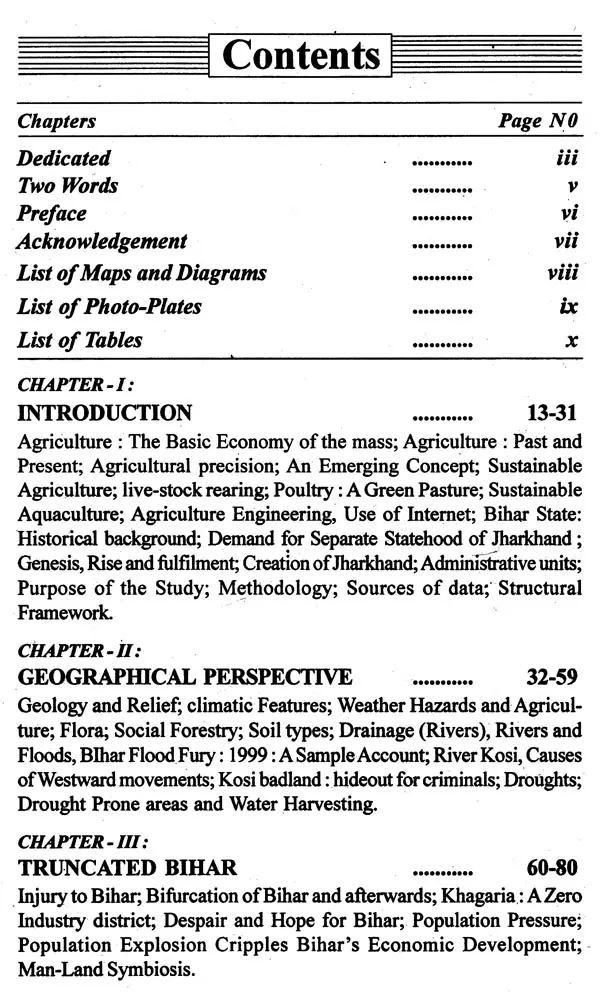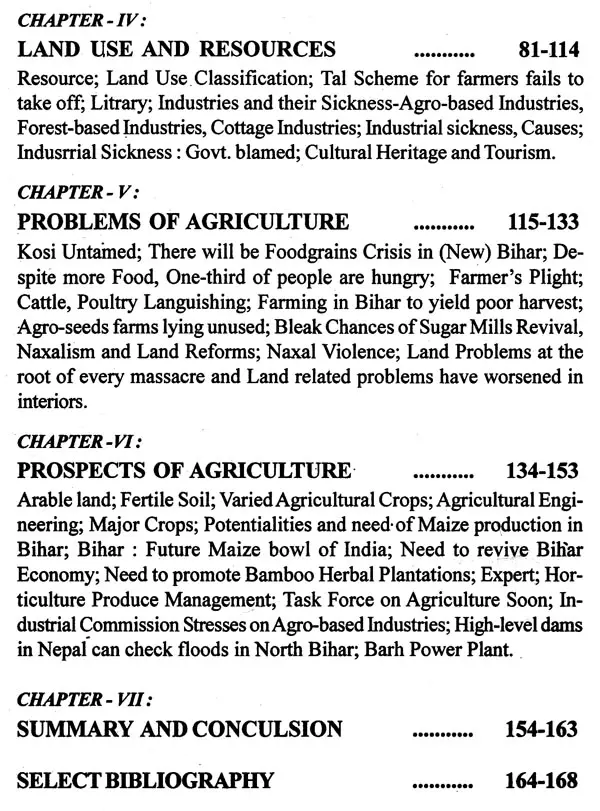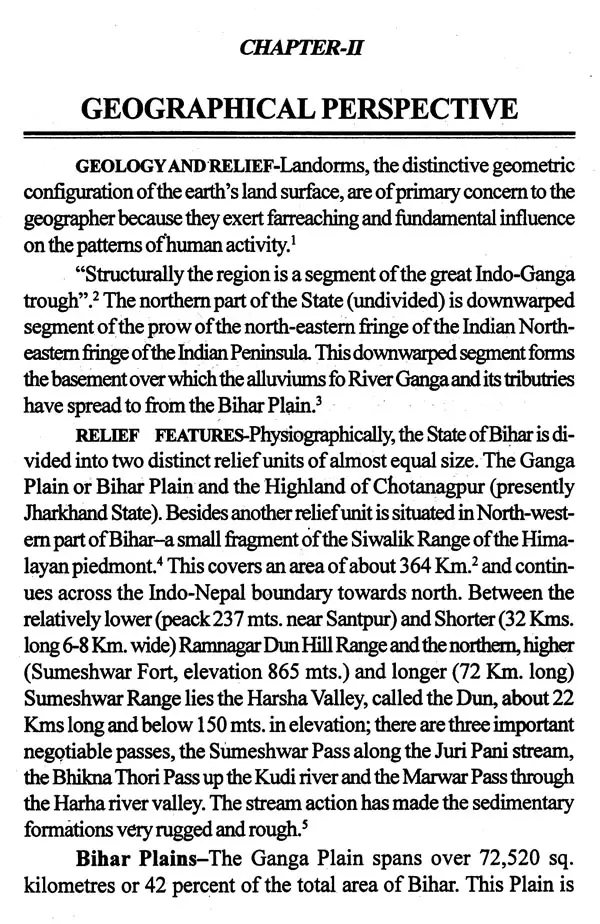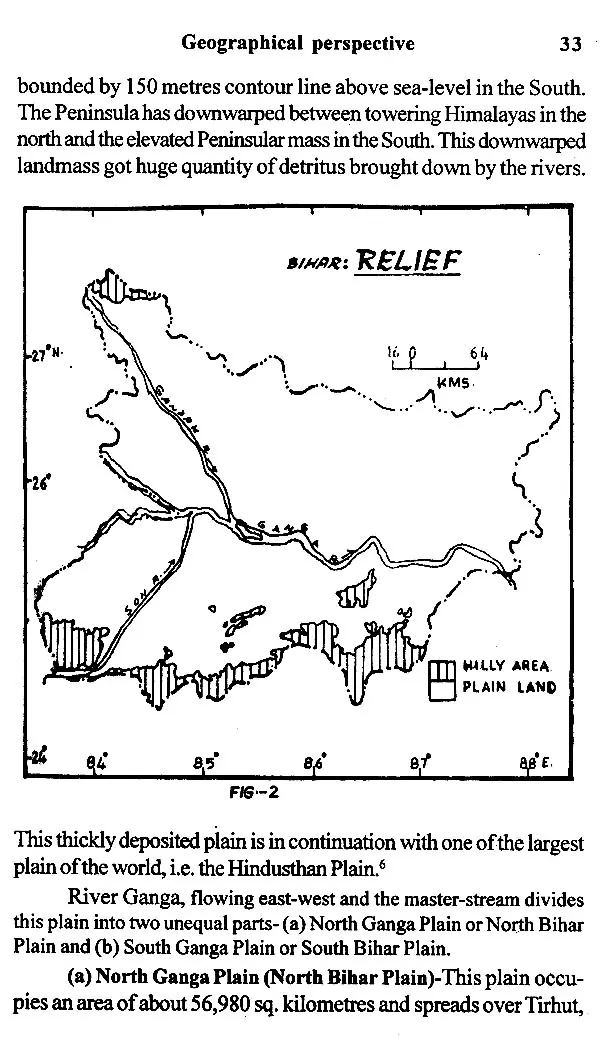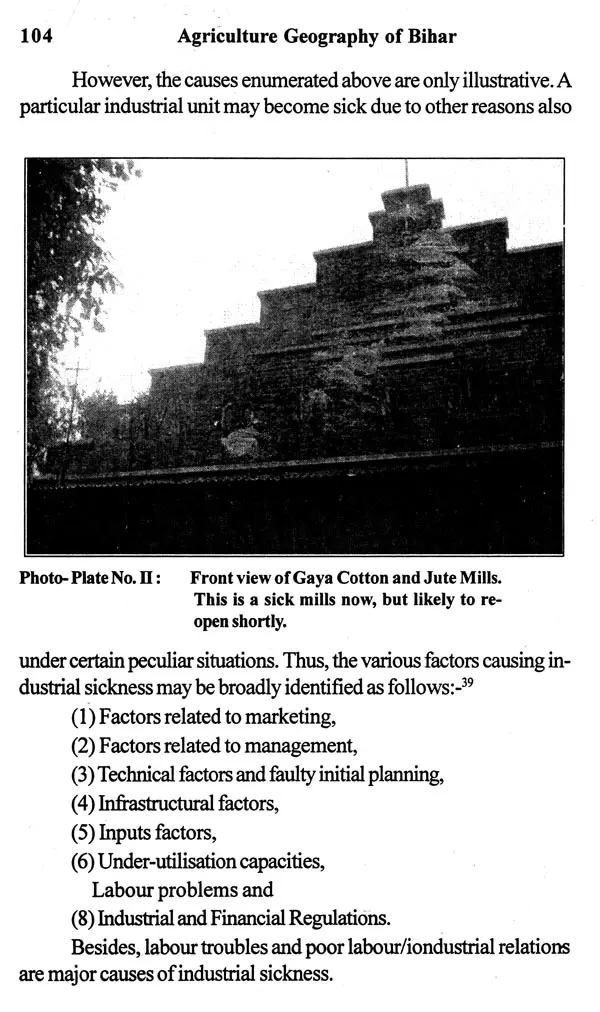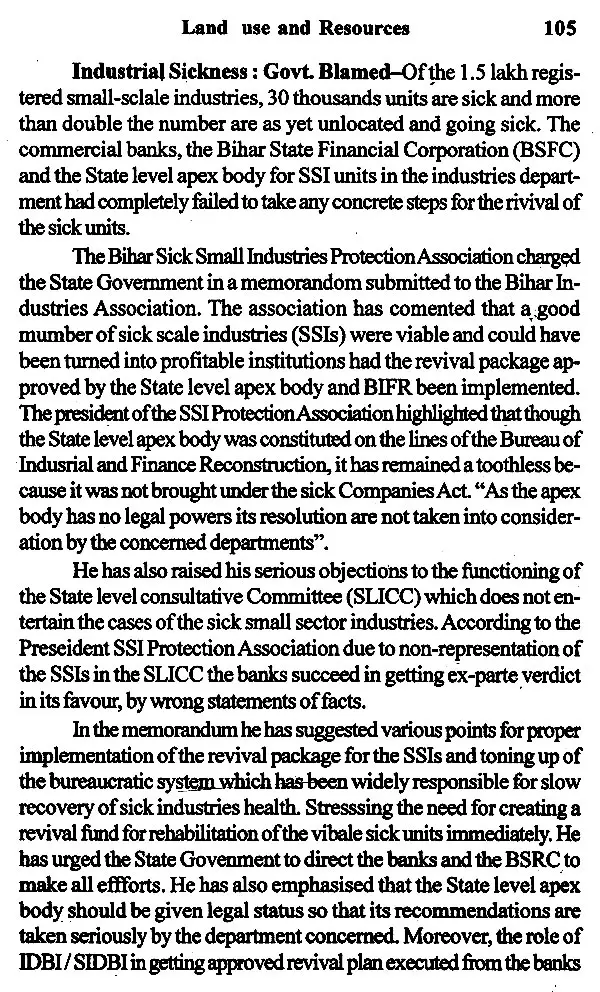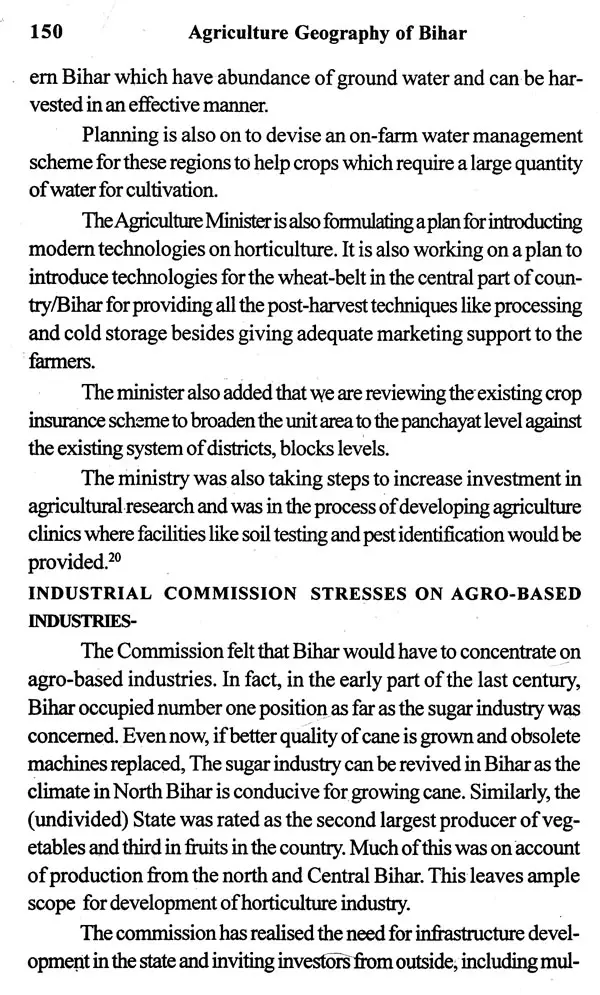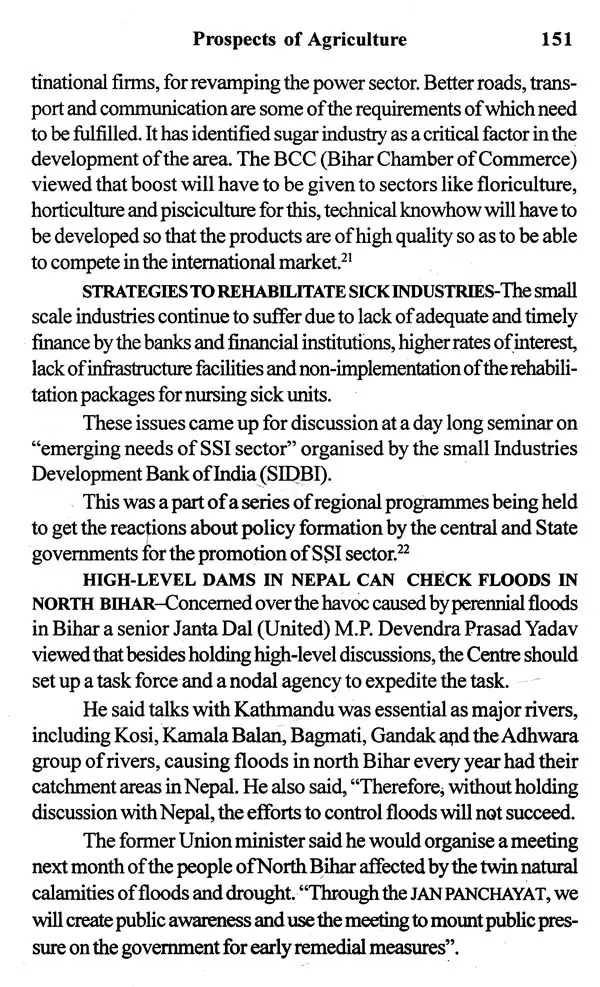
Agriculture Geography of Bihar (Problems and Prospects)
Book Specification
| Item Code: | UAF237 |
| Author: | Ashok Prasad |
| Publisher: | KALA PRAKASHAN |
| Language: | English |
| Edition: | 2016 |
| ISBN: | 9789381698839 |
| Pages: | 168 (Throughout B/W Illustrations with Maps) |
| Cover: | HARDCOVER |
| Other Details | 9.00 X 6.00 inch |
| Weight | 340 gm |
Book Description
This book entitled "AGRICULTURE GEOGRAPHY OF BIHAR" contains sublime thought concerned with disadvantages caused by bifurcation of Bihar State and Creation of new state JHARKHAND. The bifurcation of Bihar of Bihar has caused permanent injury and created various types of problems before the residual Bihar. I have discussed here that after partition of Bihar, this state faces so many disadvantages like lack of Industry, Industrial base Minerals, Over population, regular flood and draught disaster. A part from it I have also discussed the advantages of Bihar like fertile soil of Ganga plain and its tributaries, population as human resource, (specially under 50 years age Man Power), every flowing river water for the irrigation, Hydro Power project and other Industrial purposes. Bihar has not shortage of food but there is mismanagement of stores and shortage of store facilities.
This book deals with malnutrition and with sustainable agricultural development with conservation of natural resources.
This book has been divided into seven chapter including Introduction, Summary and Conclusion. The cone chapters are Geographical perspective truncated Bihar, Land use and resources, Problems of agriculture, Prospects of agriculture respectively.
This book is very useful for the students upto post graduate level and research scholars as it deals with the burning problems of Bihar State after creation of JHARKHAND.
Name Dr. Ashok Prasad, Born at Bihar Sharif, Nalanda in 1955, Graduted from Nalanda College, Nalanda an International and Historical place of learning and got M.A. and Ph.D. from M.U., Bodh Gaya in 1976 and 2003 respectably. He joined as lecturer in Nalanda Mahila College, Bihar Sharif in 1979 and got promotion as Associate Professor in 1992.
Dr. Prasad has published more than Thirty five Articles and attended many National Seminars. He has been actively engaged in Research works awarding Ph.d. degrees to more than Ten Scholars in the fields - Environmental, Agricultural Human Resources, Tourism and urban Geography etc. His hobby is to think geographical aspect minutely.
To-day we are facing a shortage not of food, but of facilities to store food. Our objective now is to overcome malnutrition. The new century will be the century of knowledge and the century of Mind. However, if the brain does not develop properly nearly one-third of our children who are under-nourished, how will we able to create those young minds that are essential to build India of our dreams in the post 21st century?
Permanency is a reflection of sustainable agricultural development while ensuring conservation of our natural resources. Over the past few decades the unit input cost in agriculture (fertilizer, pesticides, labour, electricity etc.) has lightened manifold; resulting in the agriculture being less remunerative for the farmers.
Bihar is bifurcated and a new State of Jharkhand has been created on the 15th Nov., 2000. This has caused permanent injury to Bihar. New (divided) Bihar is plunged into various problems. And now, Bihar needs to convert its disadvantages. The disadvantages of North and Central Bihar are lack of industrial base, over population and floods. The big advantage is that the soil of Bihar plains has not been exposed to excessive fertilizer to cultivate high yielding variety (HYV) crops. In this sense, Bihar soil is not as saturated as Punjab's is. So the potential for agricultural growth in Bihar is highly encouraging.
The present research-project has been divided into seven chapter, including Introduction and Summary and Conclusion. The core chapters are truncated Biahr, land use and resources, problems of agriculture and prospects of agriculture.
The work is supported by 16 neatly drawn maps and diagrams and 7 photo-illustrations.
The State of Bihar is the heart of our country. It is land-locked and is very fertile and very thickly peopled. The State of Bihar was bifurcated and a new State of Jharkhand came into existence with effect from the 15 November, 2000. Bihar is the third (2001) largest State in terms of total population.
The history of Bihar is 5000 years old. Though our presence on international scene today does not prove the age of our existence. Nations or States coming only three hundred years ago in existence are today ruling the world panorama but it is the richness of our traditions and heritage which has always been acknowledged and which surfaces itself whenever art, culture, history, philosophy and science are discussed.
More often than not, it is geographer that shaped the courses of history. Boundaries may be frivolous when we are talking of the greats like Lord Buddha and Mahavira to whom Bihar owes the glory of her past history. A form of men may liquidate into nothingness but the ideas and vision persists. In fact, the greats are immutable to the extent of defying extinction. The echoes of `Buddham, Sarnam, Gachami' and Moherira, the apostle of peace seem to be more permanent even in the fragile world of our existence.
The overflowing Ganga each year sends silt to the northern and southern Gangetic Plains making the soils more fertile. In fact the basic pride comes on our success in the field of agriculture.
Besides the heavy industries of the Plateau area (Presently Jharkhand State), the vibrancy of other Industries too has strengthened the production network providing employment to a large number of people thus bringing the stream of national advancement. No- tables among them are railway wagons plant at Barauni, Kalyanpur Cement factory at Dehri-on-Son.
The north Bihar has a nucleus of Industrial culture and exudes its potential by way of tapping livestock population for the growth of leather industry. The goatskin available particularly from Tirhut Division is internationally famous for their grain patterns under the brand Muzaffarpur variety. Similarly the KHADI and village industries pulsating with success too has occupied an enviable place in the national economy.
Bhagalpuri tassar silk has a transcendental effect. So 40% of it goes to U.S.A., 13% to Germany, 7?ch to France and Hong Kong and 5% to Austria. There are about more than 30 exporters from Bhagalpur area whose turnover is more than one lakh metres each. This is a benchmark in the silk industry.
Mango pulp and juice, pineapple slice, titbits and juice, lichi juice, Tomato, Puri and paste, Guava pulp and juice, fresh lichi, Makhana, Pickles are significant fruit food products.
But, in spite of all these, with the surging population of more than 8 crores (8, 28, 78, 796 persons, 2001), all the resources much fall short than the requirements. Bihar is a poor State and became poorer oiler partition.
Agriculture is the mainstay of the majority (Over 70%) of its population. Prosperity in agriculture is the prosperity of the mass.
Attaining food security had been the major objective before the entire nation since independence. During the mid sixties, we were importing around 8-10 million tonnes. Our food security was called' `SHIP TO MOUTH' and was based on reports in newspaper as to which ship had landed on which port and had distributed food grains to which part of the country. 'PROPHETS OF DOOM' had also called us "BEGGING BOWL". We also remember the message of the then Prime Minister, Smt. Indira Gandhi who said, "No nation live with pride unless it has the capacity to feed its people".1
Thanks to the cutting edge of Science, strong political will coupled with appropriate policy interventions and the hard labour of our farmers, India since independence achieved fourfold increase in food grain production as against threefold increase in population. It was indeed the commitment of our leaders and policy makers that we could build the required infrastructure, a very strong National Agricultural Research System (NAAS) and the competent human resource that enabled us to usher in the 'GREEN REVOLUTION'. Unfolding the success story of the "GREEN REVOLUTION' not only gives us the satisfaction on food front but also provides the much needed self-confidence and self respect to the nation. Let us remember that vision-arise like Bharat Ratna late Shri C. Subramaniam, Dr. M.S. Swaminathan, Dr. Norman E. Borlaug and late Shri B. Shivaraman had been the key architects of our "GREEN REVOLUTION'.2
Today we are facing a shortage not of food, but of facilities to store food. Our objective now is to overcome malnutrition. The new century will be the century of knowledge and the century of Mind. However, if the brain does not develop properly in nearly one-third of our children who are undernourished, how will we be able to create those young minds that are essential to build India of our dreams in the 21st century ? Mom than 50 percent of the pregnant women and children are anemic. Vitamin and protein deficiencies are rampant. These realities overshadow our achievements and burden our national conscience.3
At another level, the increase in food production that we have achieved in the past three to four decades have come at a cost of the agricultural environment. There has been both qualitative and quantitative degradation of land, water and bio-resources. Fertile lands that have become uncultivable due to water logging and salinization. Areas where yields have come down because of wrong cropping pattern and faulty usage of fertilizers, Excessive pumping of water has caused such acute depletion of water table that even drinking water has become scarce.
